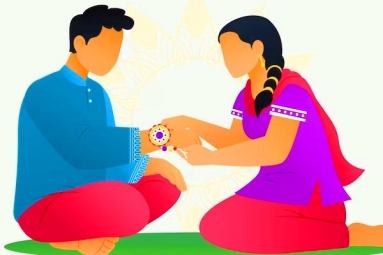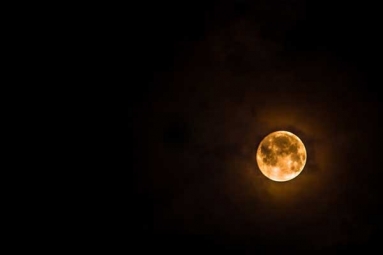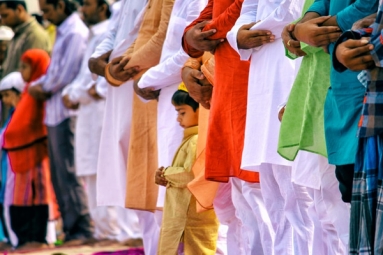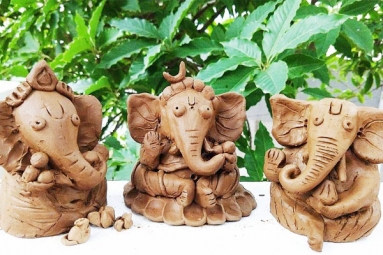
(Image source from: })
Dussehra, also known as Vijayadashami, is one of the most important Hindu festivals celebrated in various forms, across India, Nepal, Sri Lanka, and Bangladesh. The name Dussehra is derived from Sanskrit Dasha-hara literally means defeat of Dashanan Ravan by Lord Rama.
The day also marks the victory of Goddess Durga over the demon Mahishasur. Goddess fought with evils for nine nights and ten days. The name Vijayadashami is also derived from the Sanskrit words "Vijaya-dashami" literally meaning the victory on Dashami (Dashmi being the tenth lunar day of the Hindu calendar month).
Vijayadashami is celebrated on the tenth day of the month of Ashwin according to the Hindu calendar which corresponds to September or October of the Gregorian calendar. The first nine days are celebrated as Maha Navratri or Sharada Navratri and culminates on the tenth day as Dussehra.

The Durga Puja festival is celebrated from the sixth to tenth day of the bright lunar fortnight in the Hindu calendar month of Ashvin. This period falls in the fortnight corresponding to the festival is called Devi Paksha"Fortnight of the Goddess"). Devi Paksha is preceded by Mahalaya, the last day of the previous fortnight Pitri Paksha, "Fortnight of the Forefathers"), and is ended on Kojagori Lokkhi Puja "Worship of Goddess Lakshmi on Kojagori Full Moon Night. The Durga Puja festival marks the victory of Goddess Durga over the evil buffalo demon Mahishasura. Thus, the Durga Puja festival epitomises the victory of Good over Evil.

Traditions
In Kashmir, Himachal Pradesh, Uttar Pradesh, Haryana, Punjab, Uttarakhand and western Bihar, it is tradition to plant barley seeds in earthen pots on the first day of Navratri. On the day of Dasara, the nine-day-old sprouts are used as symbols of luck. Men place them in their caps or behind their ears.

Northern India and some parts of Maharashtra, celebrates Dasha-Hara in honour of Rama. During these 10 days, many plays and dramas based on Ramayana are performed, which are called Ramlila. There are outdoor fairs and large parades with effigies of Ravana, his brother Kumbhakarna and son Meghanad. The effigies are burnt on bonfires in the evening.
In the Kumaon region of Uttarakhand, the Dasara festival starts with the performance of Ramlila, which is unique, as it is based on the musical rendering of the katha or story of Lord Rama.

Dussehra at Kullu commences on the tenth day of the rising moon, i.e. on 'Vijaya Dashami' day itself and continues for seven days.
Vijayadashami is celebrated in various ways in different parts of South India. It is seen as a day to express gratitude to everything that bring success in life. Vijayadashami is celebrated as Golu in Karnataka, Kerala, Telangana, Andhra Pradesh and Tamil Nadu from Navratri onwards.

In Andhra and Telangana, younger family members usually pay respects to their elders by giving them the leaves of Shami tree/ Jambi tree, and seeking their blessing. In Karnataka, Ayudha Puja, on the ninth day of Dasha-Hara, is celebrated with the worship of implements used in daily life such as computers, books, vehicles, or kitchen tools. In Kerala, the ninth day of the Navratri festival is celebrated as Saraswati Puja. The celebrations start with the Puja Veypu (Offering for Worship). It consists of placing the books for Pooja on the Navami day. Ayudha Puja, is celebrated by business and industrial houses during this period.
In Maharashtra, the festival is celebrated on the tenth day of the month of Ashwin according to the Shaka Hindu Calendar. These three and a half days in the Hindu Lunar calendar is considered very auspicious.
Vijaya Dashami or Dussehra is celebrated as Durga Puja in two different ways in Odisha. In major Shakti Peethas like Tara Tarini (Breast Shrine of Adi Shakti) and Bimala (Jagannath Temple) or other temples of the goddesses, the Durga Puja is observed with rituals for a period of 10 to 16 days, known as Shodasa Upachara.
In Bengal, Dussehra is celebrated as Durga Puja. Deities of the goddess Durga are worshipped for five days, and on the fifth day (Vijaya Dashami) immersed in a river or pond.

People in western India, especially in Gujarat, spend the nine nights of Navaratri with song, dance and merriment. Garba is a graceful form of dance, wherein women dressed in exquisitely embroidered choli, ghagra and bandhani dupattas, dance gracefully in circles around a pot containing a lamp. The word “Garba” means “womb”, and in this context the lamp in the pot, symbolically represent life within a womb. Besides the Garba, is the “Dandia” dance, in which men and women participate in pairs with small, decorated bamboo sticks called dandias in their hands.
By Premji











